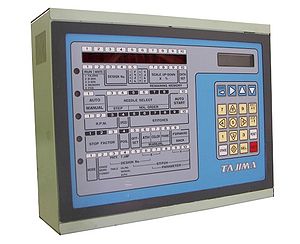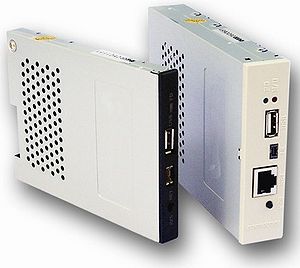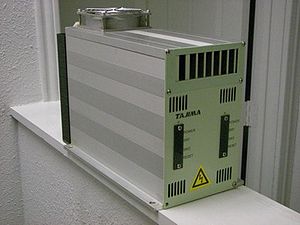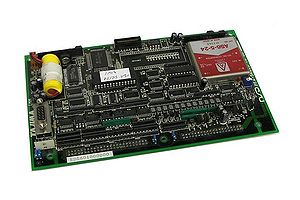Difference between revisions of "Tajima TME-DC Electronics"
| (19 intermediate revisions by the same user not shown) | |||
| Line 8: | Line 8: | ||
| embSeriesHeads = 6 - 29 | | embSeriesHeads = 6 - 29 | ||
| embSeriesNeedles = 9 - 15 | | embSeriesNeedles = 9 - 15 | ||
| embSeriesInput = Floppy, Serial, Parallel, [[ | | embSeriesInput = Floppy, Serial, Parallel, [[Floppy To USB]] | ||
}} | }} | ||
The [[Tajima TME-DC]] was one of the longest produced Tajima models. | The [[Tajima TME-DC]] was one of the longest produced Tajima models. | ||
==TME-DC Electronics== | ==TME-DC Electronics== | ||
The Tajima TME-DC machine electronics consist of the main power box (underneath the machine), the control panel, DU-10 (XY) and various other small boards such as head cards, joint cards, and communications cards. | |||
The Tajima TME-DC machine electronics consist of the main power box, control panel, DU-10 (XY) and various other small boards such as head cards and | |||
{{notice|The [[Tajima TMFD]] machine used the same electronics as the Tajima TME-DC machine. When reading this article, this model TME-DC can be replaced with TMFD}} | |||
List of boards generally found on the Tajima TME-DC models: | List of boards generally found on the Tajima TME-DC models: | ||
===Control Panel=== | |||
[[File:TME-DC_usb2.jpg |thumb|right|alt=Tajima TME-DC Control Panel with optional [[FloppyToUSB]] installed|Tajima TME-DC Control Panel with optional [[FloppyToUSB]] installed]] | |||
The TME-DC Control Panel houses the Tajima TME-DC's main computer boards which include the control panel, LCD screen, IDM card and Floppy Drive or [[Floppy To USB]] unit. The Control Panel can be opened by hand from the back with the 2 flat head hand screws. | |||
It is preferred that the entire control panel be shipped when undergoing repairs on any of the Control Panel component. | |||
===DU-10=== | ===DU-10=== | ||
[[File:DU-10.jpg|thumb|right|alt=DU-10 Dual Unit X and Y Box|DU-10 Dual Unit X and Y Box]] | [[File:DU-10.jpg|thumb|right|alt=DU-10 Dual Unit X and Y Box|DU-10 Dual Unit X and Y Box]] | ||
The DU-10 unit precedes the previous DU-6, DU-7 and DU-8 models. The DU-10 contains 2 identical cards. The cards in the DU-10 unit are the X and Y movements for the Tajima machine. | The DU-10 unit precedes the previous DU-6, DU-7 and DU-8 models. The DU-10 contains 2 identical cards. The cards in the DU-10 unit are the X and Y movements for the Tajima machine. | ||
The X and Y cards/cables can be swapped for testing purposes. Be sure the machine is turned off when testing. | |||
The X and Y cards also have potentiometers for increasing the power to the machines motors. These potentiometers should never be touched unless by a technician. Also, these potentiometers are set at the factory or at installation and are set specifically for the X or the Y motors both of which need different power input. | |||
====Errors==== | |||
When the X or Y boards start to go back either an amber light will be seen on the box or the movement either direction might sound very rough. The embroidery might not look as good or it might look scaled down on one axis. The pantograph might be easy to move in one direction or another while the machines power is still on. | |||
===IMM Card and IDM Card=== | ===IMM Card and IDM Card=== | ||
The IMM Card and IDM Card are communication cards between the control panel and the main control box. | [[File:tmedc_imm_card1.jpg|thumb|right|alt=Tajima IMM Card|Tajima IMM Card]] | ||
The IMM Card and IDM Card are communication cards between the control panel and the main control box. If the machine does not boot up but displays info on the screen such as software version numbers, then the IMM or IDM cards might need to be replaced or repaired. | |||
The following has been taken from http://www.plrelectronics.com/lab/Tajima/Repair/index.php | |||
Tajima part number ED5601000000 | |||
There are two circuit boards responsible for most errors which are the Tajima IDM and Tajima IMM and IMM2 cards, in the control panel and in the lower back of the machine, respectively. There are several versions of these boards for the TME-DC Type 1 (Green) and Type 2/Type 3 (White control panel). Other errors on the Tajima TMFD/TME-DC type of machine are due to defective brake boxes (attached to the main motor of the machine) and the main motor itself in the type2 and type3. | |||
The Tajima TME-DC embroidery machine also has a floppy drive unit which can become defective over the years, and the DU-10 type of XY control boards. | |||
====Errors==== | |||
Errors include the d-1.xx, n-1.xx errors, where the control panel becomes frozen. Other errors include the color change function acting erratically, the main motor unable to function, the brake box not being able to stop the shaft at the proper location (or hold it), the main motor not functioning at all due to a E-002 error on the newer type brake box, and the mentioned floppy drive problems. | |||
The d-1.00 error, d-1.01 error, d-1.06 error, can be about any number between 1.00 and 1.14. | |||
The DU-10 cards, which control the Tajima's X and Y-axis, can also degrade and be damaged; if there is jerky movement or the lights on each card are orange or red, please let us know. | |||
[[PLRElectronics]] also states ''Send your Tajima IMM card or IDM board in for repair today!'' | |||
===Color change card=== | ===Color change card=== | ||
| Line 28: | Line 59: | ||
===Head card=== | ===Head card=== | ||
When head cards start to go bad, the machine might report false thread breaks. Before replacing or repairing its recommend to clean the connectors where the check springs touch the copper stopper. | |||
==Troubleshooting and Error Messages== | ==Troubleshooting and Error Messages== | ||
| Line 55: | Line 82: | ||
;Tajima Error 2C2: Incorrect option, please change. | ;Tajima Error 2C2: Incorrect option, please change. | ||
;Tajima Error 2CE: Beam sensor is tripped, make sure both mirrors are aligned. | ;Tajima Error 2CE: Beam sensor is tripped, make sure both mirrors are aligned. | ||
;Tajima Error 311: Main motor not spinning. Check the S-card if it is active. Check main shaft if it is bound. ''This error generally requires circuit board repair of the S-Card, contact [ | ;Tajima Error 311: Main motor not spinning. Check the S-card if it is active. Check main shaft if it is bound. ''This error generally requires circuit board repair of the S-Card, contact [[PLRElectronics]] for repair information'' | ||
;Tajima Error 312: Main shaft encoder giving incorrect signal. Check connections. | ;Tajima Error 312: Main shaft encoder giving incorrect signal. Check connections. | ||
;Tajima Error 316: The S-card is giving an error signal. Check card. | ;Tajima Error 316: The S-card is giving an error signal. Check card. | ||
;Tajima Error 322: The X-card is giving an error signal. Check card. ''This error generally requires circuit board repair of the X-Card, contact [ | ;Tajima Error 322: The X-card is giving an error signal. Check card. ''This error generally requires circuit board repair of the X-Card, contact [[PLRElectronics]] for repair information'' | ||
;Tajima Error 323: The Y-card is giving an error signal. Check card. ''This error generally requires circuit board repair of the Y-Card, contact [ | ;Tajima Error 323: The Y-card is giving an error signal. Check card. ''This error generally requires circuit board repair of the Y-Card, contact [[PLRElectronics]] for repair information'' | ||
;Tajima Error 382: Color change motor is not moving. Check for binds. Check connections. | ;Tajima Error 382: Color change motor is not moving. Check for binds. Check connections. | ||
;Tajima Error 383: The color change location is not valid for running the head. Please check or re-center. | ;Tajima Error 383: The color change location is not valid for running the head. Please check or re-center. | ||
;Tajima Error 3D1: Battery error. ''This error generally requires circuit board repair of the Control Panel, contact [ | ;Tajima Error 3D1: Battery error. ''This error generally requires circuit board repair of the Control Panel, contact [[PLRElectronics]] for repair information'' | ||
;Tajima Error 3D6: CPU card detects problem with main program. Reinstall. | ;Tajima Error 3D6: CPU card detects problem with main program. Reinstall. | ||
;Tajima Error B01: Floppy disk format is not correct. Is the disk bad, or the floppy drive configured correctly? | ;Tajima Error B01: Floppy disk format is not correct. Is the disk bad, or the floppy drive configured correctly? | ||
| Line 82: | Line 109: | ||
==TME-DC Electronics Repairs== | ==TME-DC Electronics Repairs== | ||
[[PLRElectronics]] specialized in repair of all the Tajima TME-DC electronics. Generally it is much cheaper to have the Tajima electronics repaired rather than buying very expensive new boards. | |||
==USB Upgrade== | ==USB Upgrade== | ||
| Line 97: | Line 124: | ||
==See also== | ==See also== | ||
*''[[PLRElectronics]]'' - [http://www.plrelectronics.com/lab/Tajima/Repair/index.php Tajima Repair - Electronic Repair and Troubleshooting for Tajima circuit boards] | *''[[PLRElectronics]]'' - [http://www.plrelectronics.com/lab/Tajima/Repair/index.php Tajima Repair - Electronic Repair and Troubleshooting for Tajima circuit boards] | ||
<!--==References== | |||
==References== | {{Reflist|2}}--> | ||
==External links== | ==External links== | ||
*''[[PLRElectronics]]'' - [http://www.plrelectronics.com/lab/Tajima/Repair/index.php Tajima Repair - Electronic Repair and Troubleshooting for Tajima circuit boards] | *''[[PLRElectronics]]'' - [http://www.plrelectronics.com/lab/Tajima/Repair/index.php Tajima Repair - Electronic Repair and Troubleshooting for Tajima circuit boards] | ||
Latest revision as of 13:22, 8 September 2013
{{#invoke:Infobox|infobox}} The Tajima TME-DC was one of the longest produced Tajima models.
TME-DC Electronics
The Tajima TME-DC machine electronics consist of the main power box (underneath the machine), the control panel, DU-10 (XY) and various other small boards such as head cards, joint cards, and communications cards.
{{
{{#invoke:Namespace detect|main}}
| type = | image = {{#if:|[[file:{{{image}}}|40px|Notice]]}} | imageright = | class = | style = | textstyle =
| text = {{#if:|
}}The Tajima TMFD machine used the same electronics as the Tajima TME-DC machine. When reading this article, this model TME-DC can be replaced with TMFD
| small = | smallimage = {{#if:|[[file:{{{image}}}|30px|Notice]]}} | smallimageright = | smalltext = | subst = {{subst:substcheck}} | date = | name = Notice }}
List of boards generally found on the Tajima TME-DC models:
Control Panel

The TME-DC Control Panel houses the Tajima TME-DC's main computer boards which include the control panel, LCD screen, IDM card and Floppy Drive or Floppy To USB unit. The Control Panel can be opened by hand from the back with the 2 flat head hand screws.
It is preferred that the entire control panel be shipped when undergoing repairs on any of the Control Panel component.
DU-10
The DU-10 unit precedes the previous DU-6, DU-7 and DU-8 models. The DU-10 contains 2 identical cards. The cards in the DU-10 unit are the X and Y movements for the Tajima machine.
The X and Y cards/cables can be swapped for testing purposes. Be sure the machine is turned off when testing.
The X and Y cards also have potentiometers for increasing the power to the machines motors. These potentiometers should never be touched unless by a technician. Also, these potentiometers are set at the factory or at installation and are set specifically for the X or the Y motors both of which need different power input.
Errors
When the X or Y boards start to go back either an amber light will be seen on the box or the movement either direction might sound very rough. The embroidery might not look as good or it might look scaled down on one axis. The pantograph might be easy to move in one direction or another while the machines power is still on.
IMM Card and IDM Card
The IMM Card and IDM Card are communication cards between the control panel and the main control box. If the machine does not boot up but displays info on the screen such as software version numbers, then the IMM or IDM cards might need to be replaced or repaired.
The following has been taken from http://www.plrelectronics.com/lab/Tajima/Repair/index.php
Tajima part number ED5601000000
There are two circuit boards responsible for most errors which are the Tajima IDM and Tajima IMM and IMM2 cards, in the control panel and in the lower back of the machine, respectively. There are several versions of these boards for the TME-DC Type 1 (Green) and Type 2/Type 3 (White control panel). Other errors on the Tajima TMFD/TME-DC type of machine are due to defective brake boxes (attached to the main motor of the machine) and the main motor itself in the type2 and type3.
The Tajima TME-DC embroidery machine also has a floppy drive unit which can become defective over the years, and the DU-10 type of XY control boards.
Errors
Errors include the d-1.xx, n-1.xx errors, where the control panel becomes frozen. Other errors include the color change function acting erratically, the main motor unable to function, the brake box not being able to stop the shaft at the proper location (or hold it), the main motor not functioning at all due to a E-002 error on the newer type brake box, and the mentioned floppy drive problems.
The d-1.00 error, d-1.01 error, d-1.06 error, can be about any number between 1.00 and 1.14.
The DU-10 cards, which control the Tajima's X and Y-axis, can also degrade and be damaged; if there is jerky movement or the lights on each card are orange or red, please let us know.
PLRElectronics also states Send your Tajima IMM card or IDM board in for repair today!
Color change card
Power to the color change motor. Also reads the color change potentiometer and some solenoids.
Head card
When head cards start to go bad, the machine might report false thread breaks. Before replacing or repairing its recommend to clean the connectors where the check springs touch the copper stopper.
Troubleshooting and Error Messages
The Tajima TME-DC machine can produce the following error messages
- Tajima Error 211
- Main shaft not at fixed position. Spin manually or use the ATH function.
- Tajima Error 225
- Stitching outside of cap frame space.
- Tajima Error 281
- Color change cannot reach needle position. Check for bind. Check potentiometer.
- Tajima Error 291
- Thread break.
- Tajima Error 2B1
- Tape reader error. No reader is detected.
- Tajima Error 2B2
- Tape reader error. Data is corrupted.
- Tajima Error 2B3
- Tape reader error. End code data is incorrect.
- Tajima Error 2B4
- Tape reader error. Data is out of order. Please reset all units.
- Tajima Error 2B5
- Sequin data has an error.
- Tajima Error 2B6
- Tape reader error. No data coming in.
- Tajima Error 2B7
- Please load data first.
- Tajima Error 2B8
- Trying to run machine while data is still loading.
- Tajima Error 2B9
- Memory writing error. Try erasing all memory.
- Tajima Error 2BA
- Memory full. Erase designs.
- Tajima Error 2BB
- Cannot frame back any more.
- Tajima Error 2BC
- No data in memory here.
- Tajima Error 2C2
- Incorrect option, please change.
- Tajima Error 2CE
- Beam sensor is tripped, make sure both mirrors are aligned.
- Tajima Error 311
- Main motor not spinning. Check the S-card if it is active. Check main shaft if it is bound. This error generally requires circuit board repair of the S-Card, contact PLRElectronics for repair information
- Tajima Error 312
- Main shaft encoder giving incorrect signal. Check connections.
- Tajima Error 316
- The S-card is giving an error signal. Check card.
- Tajima Error 322
- The X-card is giving an error signal. Check card. This error generally requires circuit board repair of the X-Card, contact PLRElectronics for repair information
- Tajima Error 323
- The Y-card is giving an error signal. Check card. This error generally requires circuit board repair of the Y-Card, contact PLRElectronics for repair information
- Tajima Error 382
- Color change motor is not moving. Check for binds. Check connections.
- Tajima Error 383
- The color change location is not valid for running the head. Please check or re-center.
- Tajima Error 3D1
- Battery error. This error generally requires circuit board repair of the Control Panel, contact PLRElectronics for repair information
- Tajima Error 3D6
- CPU card detects problem with main program. Reinstall.
- Tajima Error B01
- Floppy disk format is not correct. Is the disk bad, or the floppy drive configured correctly?
- Tajima Error B02
- Floppy file system is not correct. Is the disk bad, or the floppy drive configured correctly?
- Tajima Error B03
- Floppy is marked as read-only.
- Tajima Error B04
- Floppy drive says no disk is inserted. Check drive configuration.
- Tajima Error BC1
- No Tajima designs found.
- Tajima Error BC2
- Cannot overwrite same name design.
- Tajima Error BC4
- Floppy write failed. Re-try.
- Tajima Error BC5
- Floppy disk is full.
- Tajima Error C01
- No response to floppy drive activation signal. Check drive configuration.
- Tajima Error 1B1
- Stop due to frame stepping.
- Tajima Error 1B2
- Stop due to stop code.
- Tajima Error 1B3
- Stop due to end of design.
- Tajima Error 1B4
- Stop due to thread trim.
- Tajima Error 1B5
- Stop due to sequin code.
- Tajima Error 1C1
- Stop due to stop button.
TME-DC Electronics Repairs
PLRElectronics specialized in repair of all the Tajima TME-DC electronics. Generally it is much cheaper to have the Tajima electronics repaired rather than buying very expensive new boards.
USB Upgrade

![External USB Embroidery Reader, Embroidery Black Box]](/images/thumb/Tajima_usb_reader_small.jpg/300px-Tajima_usb_reader_small.jpg)
The USB Upgrade for the TME-DC can be found at:
External Reader
The TME-DC External Reader (Embroidery Black Box) can be purchased at: USB Flash Reader Embroidery Machine Transfer System
Internal Reader (Floppy to USB)
The TME-DC (Floppy To USB) can be purchased at: Floppy To USB Upgrade

